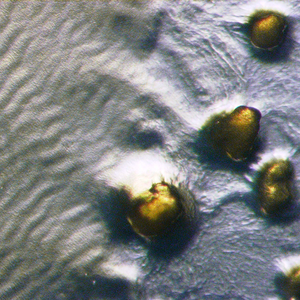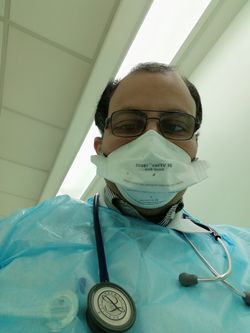Biofilms Role in Chronic Infections: Difference between revisions
(media) |
No edit summary |
||
| (9 intermediate revisions by 5 users not shown) | |||
| Line 1: | Line 1: | ||
<div class="editorbox"> '''Original Editor '''- [[User:Lucinda hampton|Lucinda hampton]] '''Top Contributors''' - {{Special:Contributors/{{FULLPAGENAME}}}}</div> | <div class="editorbox"> '''Original Editor '''- [[User:Lucinda hampton|Lucinda hampton]] '''Top Contributors''' - {{Special:Contributors/{{FULLPAGENAME}}}}</div> | ||
== Introduction == | == Introduction == | ||
[[File:Biofilm.png| | [[File:Biofilm.png|alt=|thumb|A colony of Biofilm]] | ||
A biofilm is an architectural colony of microorganisms, | A biofilm is an architectural colony of microorganisms, that is irreversibly associated (not removed by gentle rinsing) with a surface and enclosed in a matrix of primarily polysaccharide material.<ref name=":2">Donlan RM. [https://www.ncbi.nlm.nih.gov/pmc/articles/PMC2732559/ Biofilms: microbial life on surfaces.] Emerging infectious diseases. 2002 Sep;8(9):881.</ref> Biofilm contains microbial cells adherent to one-another and to a static surface (living or non-living)<ref name=":0" />. Depending on the environment it is developed, a biofilm may also contain noncellular materials such as mineral crystals, corrosion particles, clay or silt particles, or blood components. Biofilm-associated organisms also differ from their planktonic (freely suspended) counterparts with respect to the genes that are transcribed. Biofilms may form on various surfaces, like living tissues, indwelling medical devices, industrial or potable water system piping, or natural aquatic systems. <ref name=":2" /> | ||
The | Bacterial biofilms are usually pathogenic in nature and can cause hospital infections. The National Institutes of Health (NIH) revealed that among all microbial and chronic infections, 65% and 80%, respectively, are associated with biofilm formation<ref name=":0">Jamal M, Ahmad W, Andleeb S, Jalil F, Imran M, Nawaz MA, Hussain T, Ali M, Rafiq M, Kamil MA. [https://www.sciencedirect.com/science/article/pii/S1726490117302587 Bacterial biofilm and associated infections.] Journal of the Chinese Medical Association. 2018 Jan 1;81(1):7-11. Available from: https://www.sciencedirect.com/science/article/pii/S1726490117302587 (last accessed 7.10.2019)</ref>. Bacterial contamination on implants and prosthetic medical devices causing infections can be life-threatening, leading to device failure, chronic infections and high mortality and morbidity rates<ref name=":1">Khatoon Z, McTiernan CD, Suuronen EJ, Mah TF, Alarcon EI. [https://www.ncbi.nlm.nih.gov/pmc/articles/PMC6312881/ Bacterial biofilm formation on implantable devices and approaches to its treatment and prevention.] Heliyon. 2018 Dec 1;4(12):e01067. Available from: https://www.ncbi.nlm.nih.gov/pmc/articles/PMC6312881/ (last accessed 7.10.19)</ref>. Microbial biofilms cause problems in the hospital environment, generating high healthcare costs and prolonged patient stay, also at times resulting in further secondary microbial infections and various health complications. {{#ev:youtube|https://www.youtube.com/watch?v=lpI4WCM_9pM|width}}<ref>biofilm What Are Bacterial Biofilms? A Six Minute Montage Available from: https://www.youtube.com/watch?v=lpI4WCM_9pM (last accessed 7.10.19)</ref> | ||
== Infections Associated with Biofilm == | |||
Pathogens can enter the human body through trauma, medical treatments, dental procedures, or other methods. Biofilms are harmful when they come into touch with exposed wounds. The elderly, immunocompromised people, and diabetics are the most vulnerable. | |||
It is estimated that about 65% of all bacterial infections are associated with bacterial biofilms. These include both, device- and non-device-associated infections<ref name=":0" />:[[File:Infection control mask.jpg|right|frameless|333x333px]] | |||
It is estimated that about 65% of all bacterial infections are associated with bacterial biofilms. These include both, device- and non-device-associated infections<ref name=":0" />. | |||
* Device related infections (device related infections affecting 2% of joint replacements, 4% for heart valves, 10% for ventricular shunts, 40% for ventricular assisted devices) | * Device related infections (device related infections affecting 2% of joint replacements, 4% for heart valves, 10% for ventricular shunts, 40% for ventricular assisted devices) | ||
* Native valve endocarditis | * Native valve endocarditis | ||
* Central venous catheters | * [[Intravenous Lines|Central venous catheters]] | ||
* | * [[Urinary Tract Infection]] | ||
* [[Cellulitis]] | |||
* Perodontitis | * Perodontitis | ||
* Osteomyelitis | * [[Osteomyelitis]] | ||
* Cystic Fibrosis infections | * [[Cystic Fibrosis]] infections | ||
* | * [[COPD (Chronic Obstructive Pulmonary Disease)]] infections | ||
* Otitis media | * Otitis media | ||
* Rhinosinusitis | * Rhinosinusitis | ||
* Non-healing chronic wounds | * Non-healing chronic wounds | ||
* Meningitis, | * [[Meningitis]], | ||
* [[Hospital Acquired Pneumonia]] | |||
* [[Clostridium Difficile Infection CDI]] | |||
* Kidney infections, | * Kidney infections, | ||
| Line 36: | Line 30: | ||
Adversely, the large doses of antibiotics used to treat biofilms clinically have also contributed to the development of antibiotic-resistant bacteria strains. Also it has been seen that some bacteria within biofilms, called “persister cells,” are dormant variants that exhibit antibiotic tolerance and can become active when the therapy is withdrawn.<ref name=":1" /> | Adversely, the large doses of antibiotics used to treat biofilms clinically have also contributed to the development of antibiotic-resistant bacteria strains. Also it has been seen that some bacteria within biofilms, called “persister cells,” are dormant variants that exhibit antibiotic tolerance and can become active when the therapy is withdrawn.<ref name=":1" /> | ||
See also [[Infection control|Infection Control]] | |||
== Future Directions == | == Future Directions == | ||
| Line 41: | Line 37: | ||
Due to the widespread distribution of biofilms in diseases and their resilience to numerous antimicrobial treatments, biofilm research is receiving more attention. Owing to increasing antimicrobial resistance, the focus of current research is shifting from targeting bacterial growth/division that causes cell death or dormancy, towards novel approaches. | Due to the widespread distribution of biofilms in diseases and their resilience to numerous antimicrobial treatments, biofilm research is receiving more attention. Owing to increasing antimicrobial resistance, the focus of current research is shifting from targeting bacterial growth/division that causes cell death or dormancy, towards novel approaches. | ||
The 4 videos below (approx 10 minutes in total) show some of these novel approaches, take a look. | |||
{{#ev:youtube|https://www.youtube.com/watch?v=0DSA_8t4-UA&feature=youtu.be|width}}<ref>NIH Metabolomics of Bacterial Biofilms Available from: https://www.youtube.com/watch?v=0DSA_8t4-UA&feature=youtu.be (last accessed 8.10.2019)</ref> | |||
{{#ev:youtube|https://www.youtube.com/watch?v=2LDNrZldtAU&app=desktop|width}}<ref>UTSWmed Breakthrough discovery to treat prosthetic joint infections Available from: https://www.youtube.com/watch?v=2LDNrZldtAU&app=desktop (last accessed 8.10.2019)</ref> | |||
{{#ev:youtube|https://www.youtube.com/watch?v=8X5SIVbsoao|width}}<ref>MicroGen DX Javad Parvizi, MD on Biofilm Infections and Next-Gen Sequencing Available from: https://www.youtube.com/watch?v=8X5SIVbsoao (last accessed 8.10.2019)</ref> | |||
{{#ev:youtube|https://www.youtube.com/watch?v=xO9LkAAdooU&app=desktop|width}}<ref>Vomaris Innovations Wound Biofilm Formation and Disruption by Electric Field Available from: https://www.youtube.com/watch?v=xO9LkAAdooU&app=desktop (last accessed 8.10.2019)</ref> | |||
== References == | == References == | ||
<references /> | <references /> | ||
[[Category:Conditions]] | |||
[[Category:Pharmacology]] | |||
[[Category:Communicable Diseases]] | |||
[[Category:Infection prevention and control]] | |||
Latest revision as of 08:08, 14 March 2023
Introduction[edit | edit source]
A biofilm is an architectural colony of microorganisms, that is irreversibly associated (not removed by gentle rinsing) with a surface and enclosed in a matrix of primarily polysaccharide material.[1] Biofilm contains microbial cells adherent to one-another and to a static surface (living or non-living)[2]. Depending on the environment it is developed, a biofilm may also contain noncellular materials such as mineral crystals, corrosion particles, clay or silt particles, or blood components. Biofilm-associated organisms also differ from their planktonic (freely suspended) counterparts with respect to the genes that are transcribed. Biofilms may form on various surfaces, like living tissues, indwelling medical devices, industrial or potable water system piping, or natural aquatic systems. [1]
Bacterial biofilms are usually pathogenic in nature and can cause hospital infections. The National Institutes of Health (NIH) revealed that among all microbial and chronic infections, 65% and 80%, respectively, are associated with biofilm formation[2]. Bacterial contamination on implants and prosthetic medical devices causing infections can be life-threatening, leading to device failure, chronic infections and high mortality and morbidity rates[3]. Microbial biofilms cause problems in the hospital environment, generating high healthcare costs and prolonged patient stay, also at times resulting in further secondary microbial infections and various health complications.
Infections Associated with Biofilm[edit | edit source]
Pathogens can enter the human body through trauma, medical treatments, dental procedures, or other methods. Biofilms are harmful when they come into touch with exposed wounds. The elderly, immunocompromised people, and diabetics are the most vulnerable.
It is estimated that about 65% of all bacterial infections are associated with bacterial biofilms. These include both, device- and non-device-associated infections[2]:
- Device related infections (device related infections affecting 2% of joint replacements, 4% for heart valves, 10% for ventricular shunts, 40% for ventricular assisted devices)
- Native valve endocarditis
- Central venous catheters
- Urinary Tract Infection
- Cellulitis
- Perodontitis
- Osteomyelitis
- Cystic Fibrosis infections
- COPD (Chronic Obstructive Pulmonary Disease) infections
- Otitis media
- Rhinosinusitis
- Non-healing chronic wounds
- Meningitis,
- Hospital Acquired Pneumonia
- Clostridium Difficile Infection CDI
- Kidney infections,
Current Treatment Approaches[edit | edit source]
In patients, biofilms that form are resistant to the host's endogenous defences. Biofilms causing infections are progressive, and in some cases can become a chronic problem. They are treated with a combination of antibacterial therapies and tissue debridement. In the case of implant-associated infections treatment includes the delivery of high dose antibiotics according to the severity of infection, and if symptoms persist, then surgical replacement must take place.
Adversely, the large doses of antibiotics used to treat biofilms clinically have also contributed to the development of antibiotic-resistant bacteria strains. Also it has been seen that some bacteria within biofilms, called “persister cells,” are dormant variants that exhibit antibiotic tolerance and can become active when the therapy is withdrawn.[3]
See also Infection Control
Future Directions[edit | edit source]
Due to the widespread distribution of biofilms in diseases and their resilience to numerous antimicrobial treatments, biofilm research is receiving more attention. Owing to increasing antimicrobial resistance, the focus of current research is shifting from targeting bacterial growth/division that causes cell death or dormancy, towards novel approaches.
The 4 videos below (approx 10 minutes in total) show some of these novel approaches, take a look.
References[edit | edit source]
- ↑ 1.0 1.1 Donlan RM. Biofilms: microbial life on surfaces. Emerging infectious diseases. 2002 Sep;8(9):881.
- ↑ 2.0 2.1 2.2 Jamal M, Ahmad W, Andleeb S, Jalil F, Imran M, Nawaz MA, Hussain T, Ali M, Rafiq M, Kamil MA. Bacterial biofilm and associated infections. Journal of the Chinese Medical Association. 2018 Jan 1;81(1):7-11. Available from: https://www.sciencedirect.com/science/article/pii/S1726490117302587 (last accessed 7.10.2019)
- ↑ 3.0 3.1 Khatoon Z, McTiernan CD, Suuronen EJ, Mah TF, Alarcon EI. Bacterial biofilm formation on implantable devices and approaches to its treatment and prevention. Heliyon. 2018 Dec 1;4(12):e01067. Available from: https://www.ncbi.nlm.nih.gov/pmc/articles/PMC6312881/ (last accessed 7.10.19)
- ↑ biofilm What Are Bacterial Biofilms? A Six Minute Montage Available from: https://www.youtube.com/watch?v=lpI4WCM_9pM (last accessed 7.10.19)
- ↑ NIH Metabolomics of Bacterial Biofilms Available from: https://www.youtube.com/watch?v=0DSA_8t4-UA&feature=youtu.be (last accessed 8.10.2019)
- ↑ UTSWmed Breakthrough discovery to treat prosthetic joint infections Available from: https://www.youtube.com/watch?v=2LDNrZldtAU&app=desktop (last accessed 8.10.2019)
- ↑ MicroGen DX Javad Parvizi, MD on Biofilm Infections and Next-Gen Sequencing Available from: https://www.youtube.com/watch?v=8X5SIVbsoao (last accessed 8.10.2019)
- ↑ Vomaris Innovations Wound Biofilm Formation and Disruption by Electric Field Available from: https://www.youtube.com/watch?v=xO9LkAAdooU&app=desktop (last accessed 8.10.2019)








